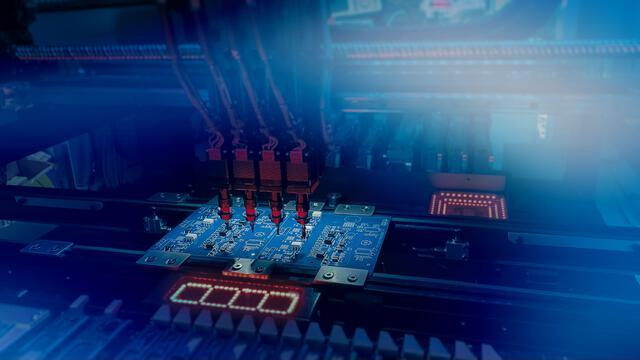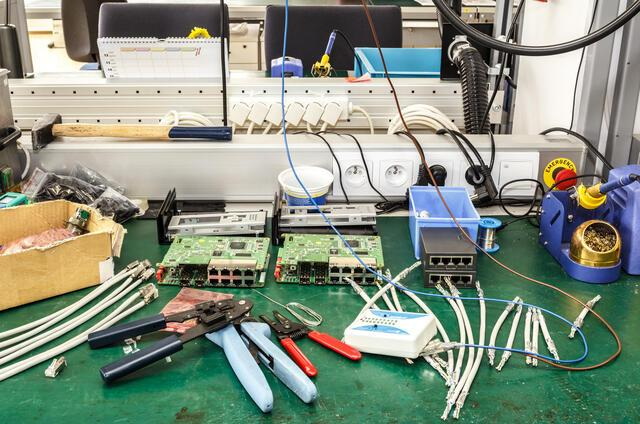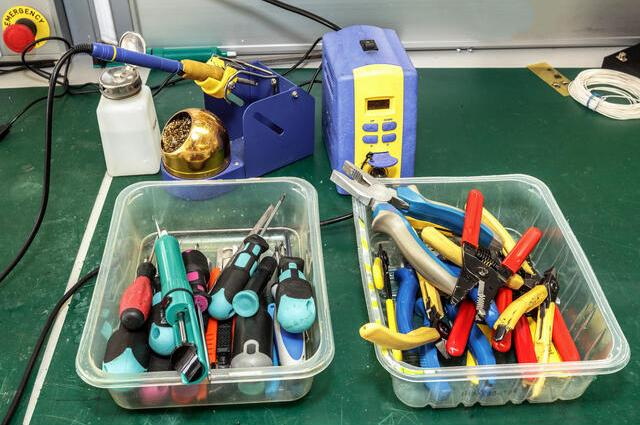Content Menu
● Understanding SMT Production
● Key Steps in Setting Up an SMT Production Line
>> 1. Planning and Preparation
>> 2. Choosing the Right Equipment
>> 3. Designing the Layout
>> 4. Setting Up Equipment
>> 5. Testing and Calibration
>> 6. Training Staff
● Budget Considerations
● Quality Assurance Measures
● Conclusion
● FAQ
>> 1. What is Surface Mount Technology (SMT)?
>> 2. What are the main components needed for an SMT line?
>> 3. How much does it cost to set up a small SMT production line?
>> 4. Why is layout important in an SMT production line?
>> 5. How do I ensure quality control in my SMT production?
Setting up a small Surface Mount Technology (SMT) production line is an essential step for businesses looking to manufacture electronic components efficiently. This guide will walk you through the necessary steps, equipment, and considerations for successfully establishing a small SMT production line.

Understanding SMT Production
SMT is a method used to mount electronic components directly onto the surface of printed circuit boards (PCBs). This technology offers numerous advantages, including increased component density, reduced manufacturing costs, and improved performance. However, setting up an SMT production line requires careful planning and execution to ensure efficiency and quality.
Key Steps in Setting Up an SMT Production Line
1. Planning and Preparation
Before diving into the setup process, it's vital to assess your production requirements:
- Determine Production Volume: Estimate how many PCBs you plan to produce daily or weekly. This estimation will help you decide on the scale of your equipment and staffing needs.
- Identify Component Types: Understand the types of components you will be using, as this will influence equipment choices. Different components may require different handling and placement techniques.
- Complexity of Assemblies: Consider the complexity of the assemblies you intend to produce, as more complex designs may require advanced equipment and skilled operators.
- Market Demand Analysis: Conduct market research to understand the demand for your products. This analysis can help you decide on the types of PCBs to manufacture and their respective features.
2. Choosing the Right Equipment
Selecting appropriate equipment is crucial for the efficiency of your SMT line. Here are the essential components you will need:
- Solder Paste Printer: This machine applies solder paste to the PCB pads where components will be placed. Look for printers with high precision and adjustable settings for different paste types.
- Pick-and-Place Machine: This is the heart of your SMT line, responsible for accurately placing components onto the PCB. Choose a machine that can handle various component sizes and shapes, as well as one that offers high speed and accuracy.
- Reflow Oven: After components are placed, they need to be soldered onto the board using a reflow oven that heats the solder paste to create a permanent bond. Consider ovens with programmable profiles to accommodate different soldering requirements.
- Inspection Systems: Automated Optical Inspection (AOI) systems check for defects in component placement and soldering quality. Implementing AOI can significantly reduce defects and improve overall product quality.
- Conveyor Systems: These facilitate the movement of PCBs through different stages of production. Ensure that your conveyor system is compatible with your other equipment and allows for easy access during maintenance.
When choosing equipment, consider factors such as compatibility with your components, ease of use, maintenance requirements, and budget constraints. Research various brands and models to find those that best fit your specific needs.
3. Designing the Layout
The layout of your SMT line should maximize efficiency and minimize bottlenecks. Considerations include:
- Flow of Materials: Arrange machines in a logical sequence that allows for smooth transitions between processes. For instance, placing the solder paste printer directly before the pick-and-place machine can streamline operations.
- Space Requirements: Ensure adequate spacing between machines for maintenance and operator movement. A cramped workspace can lead to errors and slow down production.
- Ergonomics and Safety: Design workstations with operator comfort in mind to reduce fatigue and increase productivity. Implement safety measures such as proper lighting, anti-static flooring, and accessible emergency exits.
- Future Scalability: Consider how your layout can accommodate future growth or changes in production volume. Leave room for additional machines or workstations if needed.

4. Setting Up Equipment
Once you have selected your equipment and designed your layout, it's time to set up:
- Install Equipment: Follow manufacturer instructions for installing each piece of equipment. Pay special attention to alignment for pick-and-place machines and solder paste printers.
- Configure Software: Most modern SMT machines come with software that controls their operation. Set up component libraries and define placement coordinates according to your production requirements.
- Integrate Systems: If possible, integrate all machines into a single software system for better tracking of production metrics such as speed, defect rates, and material usage.
5. Testing and Calibration
After installation, thorough testing is necessary:
- Run Test Boards: Conduct initial tests with test boards to verify that all equipment functions correctly. Use boards that mimic actual production runs to identify potential issues early on.
- Inspect Results: Check for accuracy in component placement, solder paste application, and reflow profiles. Document any discrepancies for future reference.
- Calibrate Machines: Make any necessary adjustments based on test results to ensure optimal performance. Regular calibration is essential for maintaining quality over time.
6. Training Staff
Proper training for your staff is essential for maintaining quality and efficiency:
- Operational Training: Ensure that operators are well-trained on how to use each piece of equipment effectively. Provide hands-on training sessions along with instructional materials.
- Quality Control Procedures: Implement training on inspection processes to catch defects early in production. Encourage a culture of quality where every team member feels responsible for product integrity.
- Safety Training: Educate staff about safety protocols related to machinery operation, handling materials like solder paste, and emergency procedures.
Budget Considerations
Establishing a small SMT line can vary significantly in cost depending on several factors:
- Equipment Costs: Depending on whether you choose new or used equipment, costs can range from $50,000 to $130,000 for a basic setup. Research financing options if upfront costs are prohibitive.
- Facility Setup Costs: Consider expenses related to workspace design, safety protocols, environmental controls (like ESD protection), utilities (electricity and ventilation), and any renovations needed for compliance with industry standards.
- Operational Costs: Factor in ongoing costs such as maintenance contracts, materials (solder paste, PCBs), labor (wages for operators), and overhead expenses like insurance and rent.
Quality Assurance Measures
To ensure high-quality output from your SMT line:
- Implement Quality Control Checks: Regularly inspect PCBs at various stages of production using both manual inspections and automated systems like AOI.
- Maintain Documentation: Keep detailed records of production runs including batch numbers, defect rates, machine settings used during each run, and any corrective actions taken.
- Continuous Improvement Practices: Adopt methodologies such as Six Sigma or Lean Manufacturing principles to identify areas where processes can be improved over time.
Conclusion
Setting up a small SMT production line requires careful planning and execution. By understanding your production needs, selecting appropriate equipment, designing an efficient layout, testing thoroughly, training staff effectively, managing budgets wisely, and implementing robust quality assurance measures, you can establish a successful SMT operation that meets your manufacturing goals while ensuring high-quality products at competitive prices.

FAQ
1. What is Surface Mount Technology (SMT)?
Surface Mount Technology (SMT) is a method used in electronics manufacturing where components are mounted directly onto the surface of PCBs rather than through holes. This technique allows for higher component density and improved performance while reducing manufacturing costs.
2. What are the main components needed for an SMT line?
The main components include a solder paste printer, pick-and-place machine, reflow oven, inspection systems (like AOI), and conveyor systems. Each plays a critical role in ensuring efficient assembly and high-quality output throughout the manufacturing process.
3. How much does it cost to set up a small SMT production line?
The cost can vary widely based on equipment choices but generally ranges from $50,000 to $130,000 for basic setups involving essential machinery. Additional costs include facility setup expenses like renovations or safety installations as well as ongoing operational costs such as labor and materials.
4. Why is layout important in an SMT production line?
An efficient layout minimizes bottlenecks by ensuring smooth material flow between different stages of production while facilitating easy access during maintenance tasks or inspections. Proper spacing also enhances operator comfort which contributes positively towards productivity levels over time.
5. How do I ensure quality control in my SMT production?
Implementing rigorous testing procedures during setup along with regular inspections throughout production can help maintain quality control effectively over time; additionally investing in automated inspection systems like AOI significantly reduces defects while enhancing overall product reliability through consistent monitoring practices adopted by trained personnel across all operational levels involved within this process framework established earlier on during initial phases outlined previously above here too!




















